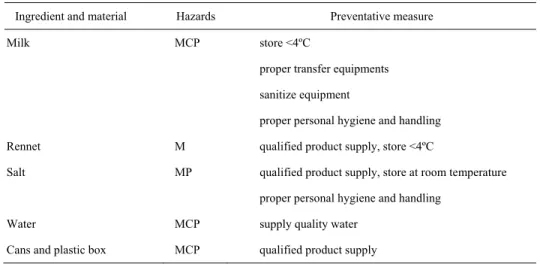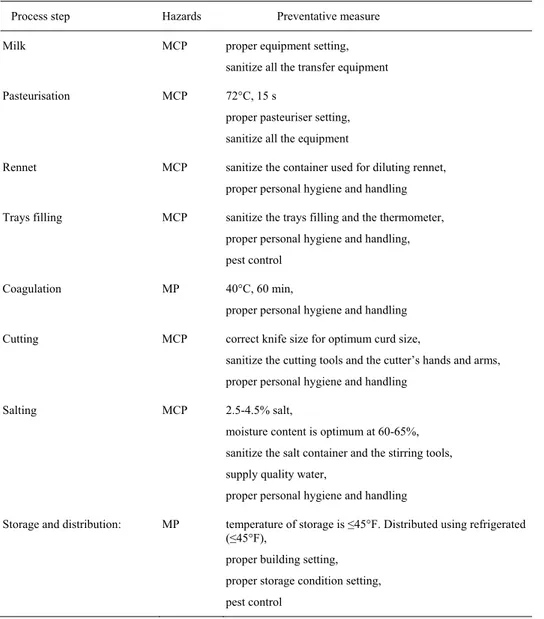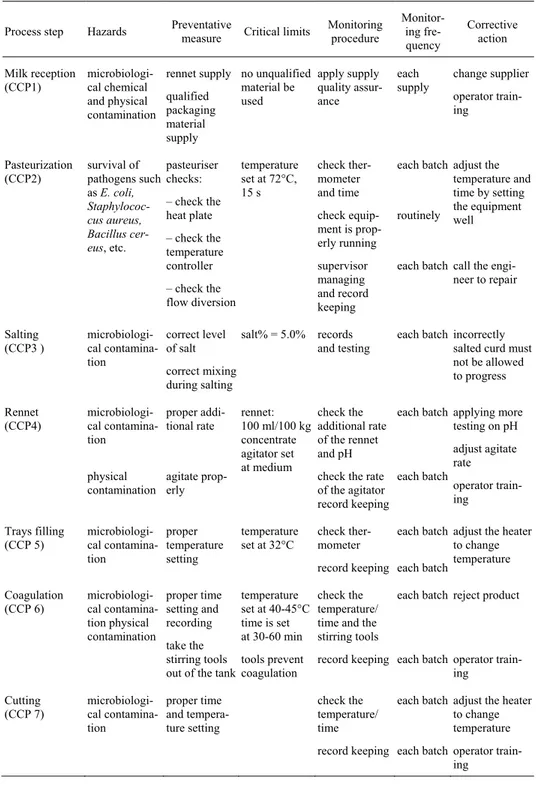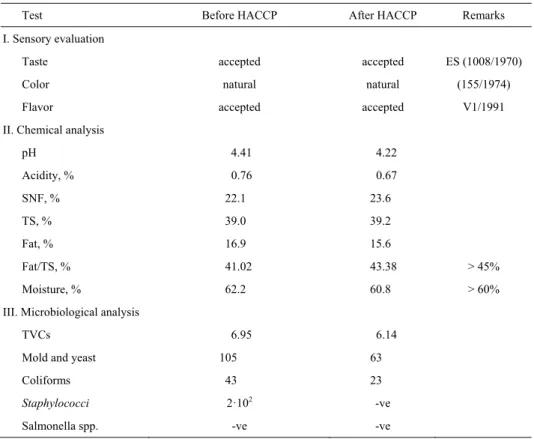S CIE
NT OR
U
M
ACTA
Acta Sci. Pol., Technol. Aliment. 9(3) 2010, 331-342
ISSN 1644-0730 (print) ISSN 1889-9594 (online)
© Copyright by Wydawnictwo Uniwersytetu Przyrodniczego w Poznaniu
Corresponding author – Adres do korespondencji: Dr Mahmoud El-Hofi, Dairy Science
Depart-IMPLEMENTATION OF THE HAZARD ANALYSIS
CRITICAL CONTROL POINT (HACCP) SYSTEM
TO UF WHITE CHEESE PRODUCTION LINE
Mahmoud El-Hofi, El-Sayed El-Tanboly, Azza Ismail
National Research Centre, Dokki, Cairo, Egypt
Background. HACCP, or the Hazard Analysis and Critical Control Point System has been recognised as an effective and rational means of assuring food safety from primary production through to final consumption, using a “farm to table” methodology. The appli-cation of this preventive oriented approach would give the food producer better control over operation, better manufacturing practices and greater efficiencies, including reduced wastes.
Material and methods. The steps taken to put HACCP in place are described and the process was monitored to assess its impact. Assessment of the hygiene quality of the UF white cheese products line before and after HACCP showed an improvement in quality and an overall improvement in the conditions at the company.
Results. HACCP was introduced for the in UF White Cheese line at Misr Milk and Food, Mansoura, Egypt, for safe and good quality foods products. All necessary quality control procedures were verified for completeness and to determine if they are being implemented to required standards. A hazard analysis was conducted to identify hazards that may occur in the product cycle, Critical Control Points (CCPs) were determined to control the identi-fied hazards. CCP signs were then posted on the factory floor. Critical limits were estab-lished at each CCP, corrective actions to be taken when monitoring indicates deviation or loss of control were established. Verification procedures were established to confirm that the HACCP system is working effectively. Documentation concerning all procedures and records was established and integrating HACCP with ISO 9000 under one management system was applied.
Conclusions. The HACCP system in this study for UF White Cheese line manufacture is developed step-by-step based on the twelve steps mentioned in the literature review. The prerequisite program was provided to deal with some hazards before the production to simplify the HACCP plan.
INTRODUCTION
Nowadays there is an ever increasing consumer demand for safe and high quality foods of prolonged life. Several quality/safety management systems (e.g., ISO 9000, Total Quality Management, and HACCP) were developed for the food industry. The importance of implementing such systems for rather biochemically unstable products like cheese [Sandrou and Arvanitoyannis 2000], a product characterised by great variety worldwide, is apparent.
HACCP, has been recognised as an effective and rational means of assuring food safety from primary production through to final consumption, using a “farm to table “methodology. HACCP was developed by the Pillsbury Company along with NASA in the 1960s. It was originally developed as a microbiological safety system to ensure food safety for astronauts. At that time most food safety and quality control systems were based on end product testing, which is an inefficient method due to product waste. Therefore, a preventative system needed to be developed to give a high level of food safety assurance [Bardic 2001, Bennet and Steed 1999, Mortimore and Wallace 1997].
The hazard analysis and critical control point (HACCP) system is a preventative measure that assesses hazards, estimates risks and establishes specific control measures that emphasize prevention rather than reliance on end-product testing [A simple guide... 1993]. The main potential hazards in most dairy products are microbiological [Tranter 1990], and the dairy industry has increased its efforts for quality and safety assurance through the development and implementation of proactive programmers such as HACCP [Ito 1974].
Cheese is the most popular dairy products in the world, produced in a great range of types and forms throughout the world countries [Fox et al. 2000]. World cheese produc-tion has increased at an average annual rate of 4.2% over the past 20 years. Investiga-tions of outbreaks of food borne diseases arising from cheese show that certain condi-tions frequently contribute to causation [FDA 2001]. When such outbreaks do occur they usually involve large number of people. Therefore the adherence to strict quality system is of paramount importance for the ensuring the safe production of cheese [Hill 2000, Temelli et al. 2006]. HACCP system is a process that identifies and assesses the hazard and risks associated with the manufacture, storage and distribution of foods and implements the appropriate control aiming at the elimination or reduction of these haz-ard at specific points of production line [Abdl-Salam 1998, Dillon and Griffith 1995, International Standard... 1998, Zhao 2003].
In cheese manufacturing, problems associated with the presence of Listeria
monocy-togenes, Salmonella enteritidis, Staphylococcus aureus, Escherichia coli and others have
been documented. The traditional quality testing and inspection used in the cheese factory is applied to the product once a problem presents itself. It is thus difficult to get 100% product inspection because of human error, obtaining sufficient samples and so on.
HACCP was originally developed as a “zero defects” program and considered to be synonymous with food safety. HACCP is a science-based system used to ensure that food safety hazards are controlled to prevent unsafe food from reaching the consumer [Bardic 2001, Mortimore and Wallace 1997, Morris 1997, IFST 1998, Smukowski 1996].
MATERIAL AND METHODS
Application of HACCP system
The steps used to apply the HACCP system in UF white cheese Products line were described by Kassem et al. [2001] as follows:
– The support of senior management of the company for food safety and HACCP application was sought and obtained.
– A team was formed which included: production manager, production engineer, consultant of food hygiene and sanitation, consultant of food microbiology and a technician from the laboratory.
– Products were described in terms of ingredients, processing, packaging, storage and distribution.
– Each step in the process was outlined in sequence in the flow diagram from raw materials through processing, packaging and storage.
– In order to identify the hazards the following actions were undertaken: – Observing operations. Each product preparation process was observed for:
• Receipt of raw materials, storage, heat treatment, cooling and packaging • Fermentation, concentration, homogenization, additives, temperature,
packag-ing and storage.
• Personal hygiene, education, health, cleanliness, habits, premises, equipment, floors, walls and ventilation (working conditions).
– Measuring operations. Time and temperature applied during the production and storage of milk and dairy products were measured and recorded on the flow dia-grams.
Evaluation of the chemical and microbiological UF white cheese quality before and after HACCP implementation
First, samples of UF white cheese were examined for physical, chemical and micro-biological contamination before HACCP application. Second, another samples (of the same products) were examined after HACCP application. The physical hazards were examined for the presence of wood, stone, bone, metals, dust and straw. The chemical analysis (pH, Acidity, Fat, Total Solids (TS), Solids Not Fat (SNF), Formalin and Anti-biotic) were described by Scott [1986]. The microbiological procedures (Detection of Total viable cell count (TVCs), coliforms, Staphylococcus aureus and Enumeration of mould and yeast) were those recommended in the International Commission on Micro-biological Specification for Foods [Microorganisms... 1996]. Culture media were those of Oxoid, Biolife and Difco.
Developing a HACCP plan of UF white cheese production line
development of a HACCP plan, five preliminary tasks need to be accomplished before the application of seven principles HACCP (Canadian Food Inspection Agency (CFIA), 2001; Fig. 1).
Assemble HACCP team Describe the final product Identify the products intended use Construct the process flow diagram Verify the flow diagram
Implement principle 1. Conduct a hazard analysis Apply principle 2. Identify the Critical Control Points (CCPs) Employ principle 3. Establish critical limits
Implement principle 4. Establish CCP monitoring procedures Organize principle 5. Establish corrective action
Institute principle 6. Establish verification procedures Principle 7. Establish record keeping procedures
Fig. 1. Summary of the HACCP system
UF White cheese operation
The main procedures to UF White cheese operation were described by Scott [1986], Kosikowski and Mistry [1997] as follows in Figure 2.
Milk reception (CCP1) Milk cooled to 5°C Storage Standardisation
Pasteurisation 72°C/15 s (CCP2) Milk heating 50-60°C
Ultra-filtration unit Concentrate, permeate Homogenised
Pasteurisation and cooling 40-45°C
Addition salt (CCP3), CaCl2, rennet solution (CCP4) Trays filling and incubation 40-45°C (CCP5) Coagulation (CCP6)
Trays cooled at 5°C Cheese cutting (CCP7) Packaging
Brine or permeate solution added Storage, distribution
Fig. 2. The main procedures and (CCPs) to UF White cheese operation
HACCP on UF White cheese production line
RESULTS AND DISCUSSION
Development of UF white cheese HACCP plan
1. Prerequisite program. There are several programs used in UF white cheese pro-duction line: 1. Buildings and facilities must be of sound construction and good repair and designed to: permit easy and adequate cleaning and proper hygiene; minimize pest and environmental contamination; minimize cross contamination; provide adequate lighting in inspection areas; provide potable water supply; provide personal hygiene practice; control surrounding areas to reduce entry of dust, runoff, pests and other po-tential contamination sources. 2. Equipment used in the process must be designed, con-structed, maintained and operated to allow for: effective cleaning of surfaces; contami-nation control; calibration and maintenance to ensure control. 3. Persons who process product should establish hygiene practice to ensure: washing of hands prior to contact with product; training is provided on critical control points, allowable tolerances and corrective actions required. 4. All employees must: be provided documented procedures to ensure the processes do not pose a health risk; adhere to documented procedures; be involved in the preparation of a HACCP system. 5. A documented sanitation program must exist that includes: equipment cleaning; housekeeping audits and associated cor-rective actions; pest control; waste disposal; bin inspections. 6. Incorporated into the existing documentation there must be: process flowcharts and critical control points; monitoring mechanism for these control points; corrective action process; traceable records. 7. A formalized customer complaint process must exist that includes a product recall process.
Table 1. Production description form
Formal product name UF White cheese
Product description and food safety characteristics: UF White cheese
moisture (%) – 60-65%
pH – 6.0-6.5
salt – 2.5-4.5%
Packaging used: cans (2-16 kg),
plastic box (650 g-1 kg)
Labelling requirements: keep refrigerated
Storage and distribution: temperature of storage is ≤7°C. Distributed using
refrigerated (≤7°C) to wholesale and retail outlets
Intended consumers: consumers of all ages consume this product
Intended use: ready to eat product
is used as packaging material, which meet the safety requirements for this line. The shelf life of this product could be longer than three month. This ready-to-eat product will be sold retail and must be distributed in a refrigerated condition and the label needs to instruct the consumers to refrigerate the product (Table 1).
3. List of product ingredients and incoming materials. All the ingredients and the possible microbiological (M), chemical (C) and physical (P) contamination or hazards in raw material will be listed in Table 2. The table also includes the preventative meas-ures for the hazards in each raw material.
Table 2. Hazards in ingredient and incoming material analysis chart
Ingredient and material Hazards Preventative measure
Milk MCP store <4ºC
proper transfer equipments
sanitize equipment
proper personal hygiene and handling
Rennet M qualified product supply, store <4ºC
Salt MP qualified product supply, store at room temperature
proper personal hygiene and handling
Water MCP supply quality water
Cans and plastic box MCP qualified product supply
M – microbiological, C – chemical, P – physical.
4. Process flow diagram. UF White cheese steps and process flow diagrams are shown in Figure 2. The adjustment is determined based on the temperature, time and salt change. If the condition cannot be controlled the product will be reject.
5. Hazard identification. In Table 3, the preventative measures are provided for the hazards in each process step. All the control situations are set up under the requirements in this line to make safe and quality UF white cheese.
6. Critical control points (CCPs) in the UF white cheese production line. The CCPs were identified according to the HACCP decision tree as recommended by [Pier-son and Corlett 1992, Codex Alimentarius... 1993, Riswadkar 2000]. The CCPs are shown in Figure 2.
Table 3. Hazard analysis chart
Process step Hazards Preventative measure
Milk MCP proper equipment setting,
sanitize all the transfer equipment
Pasteurisation MCP 72°C, 15 s
proper pasteuriser setting,
sanitize all the equipment
Rennet MCP sanitize the container used for diluting rennet,
proper personal hygiene and handling
Trays filling MCP sanitize the trays filling and the thermometer,
proper personal hygiene and handling,
pest control
Coagulation MP 40°C, 60 min,
proper personal hygiene and handling
Cutting MCP correct knife size for optimum curd size,
sanitize the cutting tools and the cutter’s hands and arms,
proper personal hygiene and handling
Salting MCP 2.5-4.5% salt,
moisture content is optimum at 60-65%,
sanitize the salt container and the stirring tools,
supply quality water,
proper personal hygiene and handling
Storage and distribution: MP temperature of storage is ≤45°F. Distributed using refrigerated (≤45°F),
proper building setting,
proper storage condition setting,
pest control
Table 4. HACCP control chart
Process step Hazards Preventative
measure Critical limits
Monitoring procedure Monitor-ing fre-quency Corrective action Milk reception (CCP1) microbiologi-cal chemimicrobiologi-cal and physical contamination rennet supply qualified packaging material supply no unqualified material be used apply supply quality assur-ance each supply change supplier operator train-ing Pasteurization (CCP2) survival of pathogens such as E. coli, Staphylococ-cus aureus, Bacillus cer-eus, etc.
pasteuriser checks:
– check the heat plate
– check the temperature controller
– check the flow diversion
temperature set at 72°C, 15 s
check ther-mometer and time
check equip-ment is prop-erly running supervisor managing and record keeping each batch routinely each batch adjust the temperature and time by setting the equipment well
call the engi-neer to repair
Salting (CCP3 ) microbiologi-cal contamina-tion correct level of salt correct mixing during salting
salt% = 5.0% records and testing
each batch incorrectly salted curd must not be allowed to progress Rennet (CCP4) microbiologi-cal contamina-tion physical contamination proper addi-tional rate agitate prop-erly rennet: 100 ml/100 kg concentrate agitator set at medium
check the additional rate of the rennet and pH
check the rate of the agitator record keeping
each batch
each batch
applying more testing on pH
adjust agitate rate operator train-ing Trays filling (CCP 5) microbiologi-cal contamina-tion proper temperature setting temperature set at 32°C
check ther-mometer
record keeping
each batch
each batch
adjust the heater to change temperature Coagulation (CCP 6) microbiologi-cal contamina-tion physical contamination proper time setting and recording take the stirring tools out of the tank
temperature set at 40-45°C time is set at 30-60 min
tools prevent coagulation
check the temperature/ time and the stirring tools record keeping each batch each batch reject product operator train-ing Cutting (CCP 7) microbiologi-cal contamina-tion proper time and tempera-ture setting
check the
temperature/ time
record keeping
each batch
each batch
adjust the heater to change temperature
Evaluation of the sensory evaluation, chemical and microbiological UF white cheese quality before and after HACCP implementation
Table 5 shows, the sensory evaluation (taste, color and flavor) and chemical analysis were identical, accepted UF white cheese samples. In the same table, shows a decrease in the hazard percentage of Staphylococcus aureus, Salmonella spp., Coliforms and Mold & Yeast detected at the UF white cheese line manufacture after applying HACCP, and the plant was then classified as a no hazard (safe) line. Salmonella and mould and yeast were not detected [Houlidou and Sampatakou 1995].
Table 5. Comparison of UF White Cheese analysis before and after HACCP
Test Before HACCP After HACCP Remarks
I. Sensory evaluation
Taste accepted accepted ES (1008/1970)
Color natural natural (155/1974)
Flavor accepted accepted V1/1991
II. Chemical analysis
pH 4.41 4.22
Acidity, % 0.76 0.67
SNF, % 22.1 23.6
TS, % 39.0 39.2
Fat, % 16.9 15.6
Fat/TS, % 41.02 43.38 > 45%
Moisture, % 62.2 60.8 > 60%
III. Microbiological analysis
TVCs 6.95 6.14
Mold and yeast 105 63
Coliforms 43 23
Staphylococci 2·102 -ve
Salmonella spp. -ve -ve
ES – Egyptian standarization, SNF – solid not fat, TS – total solids, TVCs – total viable count (Log10 CFU/ml).
CONCLUSIONS
consumer to the potential hazards in the final products. By answering the questions in the decision trees, the critical control points were determined. Finally, the HACCP con-trol chart was developed to include components of several HACCP principles which are critical limits, monitoring, corrective action and responsibility. Seven CCPS were found in the production in this cheese plant. They are: qualified supply of rennet and packag-ing material, proper pasteurization, proper settpackag-ing durpackag-ing addpackag-ing CaCl2, NaCl and ren-net, proper setting during coagulation, proper time and temperature during manufacture.
Recommendations
Establishment of standards for microbiological examination for cheese products, Developing a training program for technician who is carrying out the microbiology and chemical analysis, Compliance with the ES guideline for the production of cheese, Em-phasise on the sanitarily aspects dealing with producing cheese with minimal microbial count and Raw materials involved in the manufacture of cheese products should be of good microbiological and chemical quality.
REFERENCES
A simple guide to understanding and applying the hazard analysis critical control point concept. 1993. Int. Life Sci. Inst. Washington.
Abdl-Salam M., 1998. Effect of application of Hazard Analysis and Critical Control Point (HACCP) system in the production of hoummos with tehineh and labanch on their microbial quality. M. Sc. Thesis. Univ. Jordan Amman.
Bardic A., 2001. HACCP ready. Dairy Field 184, 6.
Bennet L., Steed L., 1999. An integrated approach to food safety. Qual. Progr. 32, 37-42.
Canadian Food Inspection Agency (CFIA). 2001. Food Safety Enhancement Program. Retrieved March 02.2003, http://www.inspection.gc.ca/english/ppc/psps/haccp/haccpe.shtml.
Codex Alimentarius Commission. 1993. Guidelines for application of Hazard Analysis and Criti-cal Control Point (HACCP) system. Codex Aliment. Comm. Food Hyg. WHO/FAO, Switzer-land.
Dillon M., Griffith C., 1995. How to HACCP. DN: M.D. Associates South Humberside.
FDA. 2001. NCIMS HACCP Pilot Program Phase II Expansion. Retrieved February 20.2003, http://www.inspection.gc.ca/english/ppc/psps/haccp/haccpe.shtml.
Fox F., Guinee P., Cogan M., McSweeney H., 2000. Fundamentals of cheese science. MD: Aspen Publ. Gaithersburg.
Hill R., 2000. Welcome to our cheese site. Retrieved October 10.2002, http://www.foodsci. uoguelph.ca/cheese/welcom.htm.
IFST. 1998. Food safety and cheese. Food Sci. Technol. Today 12, 117-122.
International Standard Organization (ISO). 1998. Guidelines for application of ISO 9001 and ISO 9002 in the food and drink industry. ISO/DIS 1516. Switzerland.
Ito K., 1974. Microbiological critical control points in canned foods. Food Technol. 28, 46-48. Houlidou A., Sampatakou O., 1995. Microbiological control of soft cheese manufactured in
mainland Greece and the Greek islands. Bull. Hellenic Veter. Med. Soc. Inst. 46, 239-242. Kassem M., Salem E., Ahwal M., Saddik M., Gomaa F., 2002. Application of hazard analysis and
critical control point system in the dairy industry. East. Medit. Health J. 8(1), 114-128. Kosikowski V., Mistry V., 1997. Cheese and fermented milk foods. VA: F.V. Kosikowski, L.L.C.
Microorganisms in Foods 5: Characteristics of microbial pathogens. 1996. Int. Comm. Microbiol. Specif. Foods. Blackie Acad. Profess. London.
Morris E., 1997. HACCP update. Retrieved February 24.2003, from http://www.foodengineer-ing.org/articles/1997/FE07751.htm.
Mortimore S., Wallace C., 1997. HACCP. Chapman and Hall New York.
Pierson D., Corlett A., 1992. HACCP: Principles and application. Van Nostrand Reinhold New York.
Riswadkar V., 2000. An introduction to HACCP the Hazard Analysis and Critical Control Point System for Food Processors. Profess. Safety 45, 33-36.
Sandrou K., Arvanitoyannis S., 2000. Application of hazard analysis critical control point (HACCP) system to the cheese-making industry: a review. Food Reviews International. Scott R., 1986. Cheesemaking practice. Elsevier Appl. Sci. Publ. New York
Smukowski M., 1996. HACCP for Italian and specialty cheese plants. Retrieved November 10.2002, from http://www.rhodiadairy.com/marschall/proceed/pdf/96_07.pdf.
Temelli S., Anar S., Sen C., Akyuva P., 2006. Determination of microbiologica contamination sources during Turkish white cheese production. Food Control 17, 856-861.
Tranter H.S., 1990. Food borne illness. Food borne staphylococcal illness. Lancet 336, 1044- -1046.
Zhao M., 2003. The design of HACCP plan for a small-scale cheese plant. Grad. School Univ. Wisconsin-Stout.
WPROWADZENIE SYSTEMU ANALIZY ZAGRO E I KRYTYCZNYCH PUNKTÓW KONTROLI (HACCP) DO PRODUKCJI SERA TWAROGOWEGO
Z ZASTOSOWANIEM ULTRAFILTRACJI
Wst p. HACCP, czyli System Analizy Zagro eń i Krytycznych Punktów Kontroli został uznany za efektywny i wymierny rodek gwarantujący bezpieczeństwo ywno ci od pro-dukcji pierwotnej a do konsumpcji, zgodnie z metodologią „od pola do stołu”. Zastoso-wanie systemu nakierowanego na prewencję daje producentowi ywno ci lepszą kontrolę operacji jednostkowych i całego procesu produkcji oraz większą efektywnoć redukcji odpadów.
Materiał i metody. Etapy objęte systemem HACCP opisano, a sam proces poddano
mo-nitoringowi w celu oceny jego działania. Analiza stanu mikrobiologicznego przed i po wprowadzeniu systemu HACCP podczas produkcji sera twarogowego po ultrafiltracji wskazała na polepszenie jako ci produktu i warunków higienicznych w przedsiębiorstwie.
Wyniki. System HACCP został wprowadzony na linii produkcji sera twarogowego z
Wnioski. System HACCP linii produkcyjnej sera twarogowego po UF został opracowany krok po kroku, zgodnie z dwunastoma etapami wymienianymi w literaturze. Programy wstępne wprowadzono w celu lepszej ochrony przed zagro eniami podczas produkcji oraz w celu ułatwienia realizacji zało onego planu HACCP.
Słowa kluczowe: HACCP, CCP (Krytyczne Punkty Kontroli), ser twarogowy po ultrafil-tracji (UF), bezpieczeństwo ywno ci
Accepted for print – Zaakceptowano do druku: 28.05.2010



